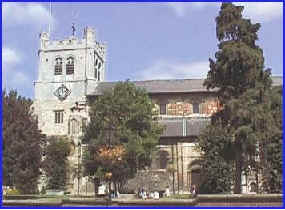
Waltham Abbey Sea Angling Club
Chairman: Mr E.Catherall Secretary: Mr S.Dieppe Est. 1992

Contact site admin’ for any matters relating to this club
Last Update
12 February, 2020
A Town full of History
Waltham Abbey is a town steeped in history. It is most famous nowadays for being the reputed resting place of King Harold who famously died at the Battle of Hastings in 1066, after suffering an arrow in his eye. King Harold's tomb is marked in the church grounds of Waltham Abbey Church in the position believed to be the high altar of the former splendid Abbey. King Harold's Standard Bearer Earl Tovi founded the Abbey. He formed a community and built a Church to serve it and it was believed the Church housed a fragment from the cross of Christ. After the Norman conquest the Norman's gave the manors in Waltham to supporters of William the Conqueror. In 1177 this was changed and the secular canons were dissolved and Henry II revested the tithes of the manors in the Abbey and re-
It officially became an Abbey in 1184. Extensive buildings were erected at the Eastern end in contrast to the great Norman Naive and for many years the Abbey had a powerful influence on the area with many noble associations and was often visited by monarchs who hunted in the Royal forest. A most distinguished guest was Cranmer, Archbishop of Canterbury, who later had much to do with events that led to the reformation.
Throughout the Middle Ages the Abbey and surrounding areas thrived and rights to hold a market and fairs were granted during the reign of Richard I, and the fairs became great events. The Abbey has the distinction of being the last great Abbey to go under the reformation in 1540. After this the lands passed to Sir Anthony Denny and the great monastic buildings were destroyed leaving just the original naive.
Waltham Abbey lies on the Greenwich Meridian 0 degrees longitude.
The Town still retains character from long ago with timber framed buildings overlooking Market Square where the town has enjoyed a market for the past 700 years (now held Tuesdays and Saturdays). Other significant historical remains include Harold's Bridge, also known as Stoney Bridge, which was built in the 14th Century across the Cornmill stream and the 12th Century Abbey Gateway, which still stands to this day and is remarkably well preserved.
Other places of interest in Waltham Abbey include the Museum which is situated in Sun Street in two timber framed houses dating from 1520 and there is the Lea Valley Parks Countryside Centre with it's beautiful rose gardens and dragon fly sanctuary. To the West side of the town is the Lea Navigational Canal, once used to transport gunpowder along the River Lea to London docks. The gunpowder was manufactured in the now closed former Royal Gunpowder Mills which spanned 184 acres. The Ministry of Defence who ran the Gunpowder Mills for 300 years have now given the site to a Trust with a sizeable endowment and the site will open as a Gunpowder Museum in the year 2000.

Waltham Abbey
Waltham Abbey is located in the west corner of the county of Essex, between the River Lea and Epping Forest.It can be accessed from the M25 motorway and there is a WAGN (West Anglia Great Northern) Railway Station at nearby Waltham Cross. You can also get there via the River Lea which runs through Hertfordshire and Essex